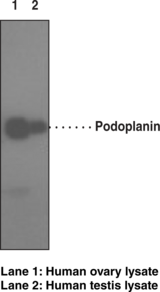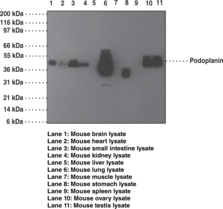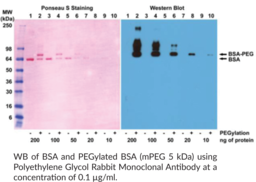Cayman
Showing 35551–35700 of 45550 results
-
PLX5622 is a brain-penetrant inhibitor of the colony stimulating factor 1 receptor (CSF1R; IC50 = 0.016 µM).{53727} It is selective for CSF1R over FMS-related tyrosine kinase 3 (FLT3), Kit, Aurora C, and kinase insert domain receptor (KDR; IC50s = 0.39, 0.86, 1, and 1.1 µM, respectively) and is greater than 100-fold selective for CSF1R over a panel of 230 kinases.{53727,53728} PLX5622 (65 mg/kg) reduces the number of Iba-1+ cells, a marker of reduced microglia activation, in the dorsal horn of the spinal cord in a mouse model of neuropathic pain induced by partial ligation of the sciatic nerve.{53728} It also decreases macrophage levels of TNF-α and IL-1β and infiltration into the sciatic nerve, as well as alleviates mechanical and cold allodynia in the same model. Dietary administration of PLX5622 (1,200 ppm in chow) decreases the number of hippocampal microglia by 90%, as well as reduces the number and volume of retrosplenial and somatosensory cortical amyloid-β (Aβ) plaques in the 5XFAD transgenic mouse model of Alzheimer’s disease.{53727}
Brand:CaymanSKU:28927 - 25 mgAvailable on backorder
PLX5622 is a brain-penetrant inhibitor of the colony stimulating factor 1 receptor (CSF1R; IC50 = 0.016 µM).{53727} It is selective for CSF1R over FMS-related tyrosine kinase 3 (FLT3), Kit, Aurora C, and kinase insert domain receptor (KDR; IC50s = 0.39, 0.86, 1, and 1.1 µM, respectively) and is greater than 100-fold selective for CSF1R over a panel of 230 kinases.{53727,53728} PLX5622 (65 mg/kg) reduces the number of Iba-1+ cells, a marker of reduced microglia activation, in the dorsal horn of the spinal cord in a mouse model of neuropathic pain induced by partial ligation of the sciatic nerve.{53728} It also decreases macrophage levels of TNF-α and IL-1β and infiltration into the sciatic nerve, as well as alleviates mechanical and cold allodynia in the same model. Dietary administration of PLX5622 (1,200 ppm in chow) decreases the number of hippocampal microglia by 90%, as well as reduces the number and volume of retrosplenial and somatosensory cortical amyloid-β (Aβ) plaques in the 5XFAD transgenic mouse model of Alzheimer’s disease.{53727}
Brand:CaymanSKU:28927 - 5 mgAvailable on backorder
PLX647 is a dual inhibitor of the receptor tyrosine kinases FMS and KIT (IC50s = 28 and 16 nM, respectively).{37558} It is selective for FMS and KIT but does inhibit FLT3 and KDR (IC50s = 91 and 130 nM, respectively) in a panel of 400 kinases at a concentration of 1 μM. PLX647 inhibits proliferation of Ba/F3 cells expressing constitutively active FMS or KIT (IC50s = 92 and 180 nM, respectively) as well as ligand-dependent growth of M-NFS-60 and M-07e cells that express endogenous FMS and KIT, respectively (IC50s = 380 and 230 nM, respectively). It has no effect on HEK293T or HepG2 cells that lack FMS and KIT (IC50 = >50 μM) or Ba/F3 cells overexpressing KDR (IC50 = >5 μM). PLX647 also inhibits differentiation of human osteoclast precursor cells (IC50 = 170 nM). In vivo, PLX647 (40 mg/kg) reduces TNF-α and IL-6 release in a rat model of LPS-induced cytokine release. It reduces mast cell degranulation in a mouse model of passive cutaneous anaphylaxis (PCA) and inhibits bone destruction and delays disease progression in a mouse model of collagen-induced arthritis (CIA). PLX647 also reverses bone osteolysis and allodynia in a syngeneic rat model of cancer-induced bone pain.
Brand:CaymanSKU:-Available on backorder
PLX647 is a dual inhibitor of the receptor tyrosine kinases FMS and KIT (IC50s = 28 and 16 nM, respectively).{37558} It is selective for FMS and KIT but does inhibit FLT3 and KDR (IC50s = 91 and 130 nM, respectively) in a panel of 400 kinases at a concentration of 1 μM. PLX647 inhibits proliferation of Ba/F3 cells expressing constitutively active FMS or KIT (IC50s = 92 and 180 nM, respectively) as well as ligand-dependent growth of M-NFS-60 and M-07e cells that express endogenous FMS and KIT, respectively (IC50s = 380 and 230 nM, respectively). It has no effect on HEK293T or HepG2 cells that lack FMS and KIT (IC50 = >50 μM) or Ba/F3 cells overexpressing KDR (IC50 = >5 μM). PLX647 also inhibits differentiation of human osteoclast precursor cells (IC50 = 170 nM). In vivo, PLX647 (40 mg/kg) reduces TNF-α and IL-6 release in a rat model of LPS-induced cytokine release. It reduces mast cell degranulation in a mouse model of passive cutaneous anaphylaxis (PCA) and inhibits bone destruction and delays disease progression in a mouse model of collagen-induced arthritis (CIA). PLX647 also reverses bone osteolysis and allodynia in a syngeneic rat model of cancer-induced bone pain.
Brand:CaymanSKU:-Available on backorder
PLX647 is a dual inhibitor of the receptor tyrosine kinases FMS and KIT (IC50s = 28 and 16 nM, respectively).{37558} It is selective for FMS and KIT but does inhibit FLT3 and KDR (IC50s = 91 and 130 nM, respectively) in a panel of 400 kinases at a concentration of 1 μM. PLX647 inhibits proliferation of Ba/F3 cells expressing constitutively active FMS or KIT (IC50s = 92 and 180 nM, respectively) as well as ligand-dependent growth of M-NFS-60 and M-07e cells that express endogenous FMS and KIT, respectively (IC50s = 380 and 230 nM, respectively). It has no effect on HEK293T or HepG2 cells that lack FMS and KIT (IC50 = >50 μM) or Ba/F3 cells overexpressing KDR (IC50 = >5 μM). PLX647 also inhibits differentiation of human osteoclast precursor cells (IC50 = 170 nM). In vivo, PLX647 (40 mg/kg) reduces TNF-α and IL-6 release in a rat model of LPS-induced cytokine release. It reduces mast cell degranulation in a mouse model of passive cutaneous anaphylaxis (PCA) and inhibits bone destruction and delays disease progression in a mouse model of collagen-induced arthritis (CIA). PLX647 also reverses bone osteolysis and allodynia in a syngeneic rat model of cancer-induced bone pain.
Brand:CaymanSKU:-Available on backorder
PLX647 is a dual inhibitor of the receptor tyrosine kinases FMS and KIT (IC50s = 28 and 16 nM, respectively).{37558} It is selective for FMS and KIT but does inhibit FLT3 and KDR (IC50s = 91 and 130 nM, respectively) in a panel of 400 kinases at a concentration of 1 μM. PLX647 inhibits proliferation of Ba/F3 cells expressing constitutively active FMS or KIT (IC50s = 92 and 180 nM, respectively) as well as ligand-dependent growth of M-NFS-60 and M-07e cells that express endogenous FMS and KIT, respectively (IC50s = 380 and 230 nM, respectively). It has no effect on HEK293T or HepG2 cells that lack FMS and KIT (IC50 = >50 μM) or Ba/F3 cells overexpressing KDR (IC50 = >5 μM). PLX647 also inhibits differentiation of human osteoclast precursor cells (IC50 = 170 nM). In vivo, PLX647 (40 mg/kg) reduces TNF-α and IL-6 release in a rat model of LPS-induced cytokine release. It reduces mast cell degranulation in a mouse model of passive cutaneous anaphylaxis (PCA) and inhibits bone destruction and delays disease progression in a mouse model of collagen-induced arthritis (CIA). PLX647 also reverses bone osteolysis and allodynia in a syngeneic rat model of cancer-induced bone pain.
Brand:CaymanSKU:-Available on backorder
PLX7904 is a RAF inhibitor (IC50s = 2.4, 140, and 91 nM for mutant B-RAFV600E, wild-type B-RAF, and C-RAF, respectively).{38489} It inhibits phosphorylation of ERK in A375 and COLO 829 cells (IC50s = 16 and 18 nM, respectively). Unlike PLX4032 (Item No. 10618), BAY 43-9006 (Item No. 10009644), and dabrafenib (Item No. 16989), PLX7904 does not induce paradoxical pERK activation and proliferation of cancer cell lines (EC50s = >200 μM). PLX7904 (25 mg/kg twice per day) inhibits tumor growth in a mouse COLO 205 colon cancer xenograft model.
Brand:CaymanSKU:20710 -Available on backorder
PLX7904 is a RAF inhibitor (IC50s = 2.4, 140, and 91 nM for mutant B-RAFV600E, wild-type B-RAF, and C-RAF, respectively).{38489} It inhibits phosphorylation of ERK in A375 and COLO 829 cells (IC50s = 16 and 18 nM, respectively). Unlike PLX4032 (Item No. 10618), BAY 43-9006 (Item No. 10009644), and dabrafenib (Item No. 16989), PLX7904 does not induce paradoxical pERK activation and proliferation of cancer cell lines (EC50s = >200 μM). PLX7904 (25 mg/kg twice per day) inhibits tumor growth in a mouse COLO 205 colon cancer xenograft model.
Brand:CaymanSKU:20710 -Available on backorder
PLX7904 is a RAF inhibitor (IC50s = 2.4, 140, and 91 nM for mutant B-RAFV600E, wild-type B-RAF, and C-RAF, respectively).{38489} It inhibits phosphorylation of ERK in A375 and COLO 829 cells (IC50s = 16 and 18 nM, respectively). Unlike PLX4032 (Item No. 10618), BAY 43-9006 (Item No. 10009644), and dabrafenib (Item No. 16989), PLX7904 does not induce paradoxical pERK activation and proliferation of cancer cell lines (EC50s = >200 μM). PLX7904 (25 mg/kg twice per day) inhibits tumor growth in a mouse COLO 205 colon cancer xenograft model.
Brand:CaymanSKU:20710 -Available on backorder
PLX7904 is a RAF inhibitor (IC50s = 2.4, 140, and 91 nM for mutant B-RAFV600E, wild-type B-RAF, and C-RAF, respectively).{38489} It inhibits phosphorylation of ERK in A375 and COLO 829 cells (IC50s = 16 and 18 nM, respectively). Unlike PLX4032 (Item No. 10618), BAY 43-9006 (Item No. 10009644), and dabrafenib (Item No. 16989), PLX7904 does not induce paradoxical pERK activation and proliferation of cancer cell lines (EC50s = >200 μM). PLX7904 (25 mg/kg twice per day) inhibits tumor growth in a mouse COLO 205 colon cancer xenograft model.
Brand:CaymanSKU:20710 -Available on backorder
Brand:CaymanSKU:400145 - 1 eaAvailable on backorder
PMK ethyl glycidate (Item No. 21990) is an analytical reference standard that is categorized as a precursor in the synthesis of methylenedioxy phenethylamines and amphetamines, including 3,4-MDMA (Item Nos. 13971 | ISO60190). This product is intended for research and forensic applications.
Brand:CaymanSKU:21990 -Out of stock
PMK ethyl glycidate (Item No. 21990) is an analytical reference standard that is categorized as a precursor in the synthesis of methylenedioxy phenethylamines and amphetamines, including 3,4-MDMA (Item Nos. 13971 | ISO60190). This product is intended for research and forensic applications.
Brand:CaymanSKU:21990 -Out of stock
PMK methyl glycidate (Item No. 21833) is an analytical reference standard that is categorized as a precursor in the synthesis of methylenedioxy phenethylamines and amphetamines, including 3,4-MDMA (Item No. 13971). This product is intended for research and forensic applications.
Brand:CaymanSKU:21833 -Out of stock
PMK methyl glycidate (Item No. 21833) is an analytical reference standard that is categorized as a precursor in the synthesis of methylenedioxy phenethylamines and amphetamines, including 3,4-MDMA (Item No. 13971). This product is intended for research and forensic applications.
Brand:CaymanSKU:21833 -Out of stock
PMX-205 is a cyclic hexapeptide that acts as a potent antagonist of C5a receptor (C5aR; IC50 = 31 nM).{33561} It is orally active and blocks inflammatory signaling and symptoms in animal models of colitis and allergic asthma.{33559,33562} PMX-205 is also brain penetrant and reduces neuroinflammation and neurodegeneration in an animal model of Alzheimer’s disease.{33558}
Brand:CaymanSKU:-PMX-205 is a cyclic hexapeptide that acts as a potent antagonist of C5a receptor (C5aR; IC50 = 31 nM).{33561} It is orally active and blocks inflammatory signaling and symptoms in animal models of colitis and allergic asthma.{33559,33562} PMX-205 is also brain penetrant and reduces neuroinflammation and neurodegeneration in an animal model of Alzheimer’s disease.{33558}
Brand:CaymanSKU:-PND1186 is a potent reversible focal adhesion kinase (FAK) inhibitor with an IC50 value of 1.5 nM against the recombinant enzyme and 100 nM in breast carcinoma cells.{32667} It promotes 4T1 breast carcinoma and ID8 ovarian carcinoma cell apoptosis when grown in anchorage-independent 3D cultures but had limited efficacy in 2D cultures. It is orally bioavailable, reducing orthotopic breast cancer tumor growth in mouse models.{32668}
Brand:CaymanSKU:-Available on backorder
PND1186 is a potent reversible focal adhesion kinase (FAK) inhibitor with an IC50 value of 1.5 nM against the recombinant enzyme and 100 nM in breast carcinoma cells.{32667} It promotes 4T1 breast carcinoma and ID8 ovarian carcinoma cell apoptosis when grown in anchorage-independent 3D cultures but had limited efficacy in 2D cultures. It is orally bioavailable, reducing orthotopic breast cancer tumor growth in mouse models.{32668}
Brand:CaymanSKU:-Available on backorder
PND1186 is a potent reversible focal adhesion kinase (FAK) inhibitor with an IC50 value of 1.5 nM against the recombinant enzyme and 100 nM in breast carcinoma cells.{32667} It promotes 4T1 breast carcinoma and ID8 ovarian carcinoma cell apoptosis when grown in anchorage-independent 3D cultures but had limited efficacy in 2D cultures. It is orally bioavailable, reducing orthotopic breast cancer tumor growth in mouse models.{32668}
Brand:CaymanSKU:-Available on backorder
PND1186 is a potent reversible focal adhesion kinase (FAK) inhibitor with an IC50 value of 1.5 nM against the recombinant enzyme and 100 nM in breast carcinoma cells.{32667} It promotes 4T1 breast carcinoma and ID8 ovarian carcinoma cell apoptosis when grown in anchorage-independent 3D cultures but had limited efficacy in 2D cultures. It is orally bioavailable, reducing orthotopic breast cancer tumor growth in mouse models.{32668}
Brand:CaymanSKU:-Available on backorder
Pneumocandin B0 is an antifungal lipopeptide that acts by inhibiting the synthesis of β-(1,3)-D-glucan, a component of fungal cell walls (IC50s = 70 and 67 ng/ml for inhibiting glucan synthase in C. albicans and A. fumigatus, respectively).{33430} It can be used to synthesize the echinocandin caspofungin acetate (Item No. 15923).{33419}
Brand:CaymanSKU:21527 -Out of stock
Pneumocandin B0 is an antifungal lipopeptide that acts by inhibiting the synthesis of β-(1,3)-D-glucan, a component of fungal cell walls (IC50s = 70 and 67 ng/ml for inhibiting glucan synthase in C. albicans and A. fumigatus, respectively).{33430} It can be used to synthesize the echinocandin caspofungin acetate (Item No. 15923).{33419}
Brand:CaymanSKU:21527 -Out of stock
Pneumocandin B0 is an antifungal lipopeptide that acts by inhibiting the synthesis of β-(1,3)-D-glucan, a component of fungal cell walls (IC50s = 70 and 67 ng/ml for inhibiting glucan synthase in C. albicans and A. fumigatus, respectively).{33430} It can be used to synthesize the echinocandin caspofungin acetate (Item No. 15923).{33419}
Brand:CaymanSKU:21527 -Out of stock
Pneumocandin B0 is an antifungal lipopeptide that acts by inhibiting the synthesis of β-(1,3)-D-glucan, a component of fungal cell walls (IC50s = 70 and 67 ng/ml for inhibiting glucan synthase in C. albicans and A. fumigatus, respectively).{33430} It can be used to synthesize the echinocandin caspofungin acetate (Item No. 15923).{33419}
Brand:CaymanSKU:21527 -Out of stock
pNPS-DHA is an arylamide derivative of docosahexaenoyl ethanolamide (DHEA; Item No. 10007534) that has anti-allergic activity.{50711} It inhibits degranulation of RBL-2H3 mast cells (IC50 = 15 µM). pNPS-DHA (1,000 mg/kg) inhibits IgE-dependent passive cutaneous anaphylaxis (PCA) in mice.
Brand:CaymanSKU:29507 - 1 mgAvailable on backorder
pNPS-DHA is an arylamide derivative of docosahexaenoyl ethanolamide (DHEA; Item No. 10007534) that has anti-allergic activity.{50711} It inhibits degranulation of RBL-2H3 mast cells (IC50 = 15 µM). pNPS-DHA (1,000 mg/kg) inhibits IgE-dependent passive cutaneous anaphylaxis (PCA) in mice.
Brand:CaymanSKU:29507 - 10 mgAvailable on backorder
pNPS-DHA is an arylamide derivative of docosahexaenoyl ethanolamide (DHEA; Item No. 10007534) that has anti-allergic activity.{50711} It inhibits degranulation of RBL-2H3 mast cells (IC50 = 15 µM). pNPS-DHA (1,000 mg/kg) inhibits IgE-dependent passive cutaneous anaphylaxis (PCA) in mice.
Brand:CaymanSKU:29507 - 25 mgAvailable on backorder
pNPS-DHA is an arylamide derivative of docosahexaenoyl ethanolamide (DHEA; Item No. 10007534) that has anti-allergic activity.{50711} It inhibits degranulation of RBL-2H3 mast cells (IC50 = 15 µM). pNPS-DHA (1,000 mg/kg) inhibits IgE-dependent passive cutaneous anaphylaxis (PCA) in mice.
Brand:CaymanSKU:29507 - 5 mgAvailable on backorder
PNU 100480 is an oxazolidinone antibiotic that is active against multidrug resistant tuberculosis.{46435} It inhibits the growth of M. tuberculosis replicating and nonreplicating strains (MIC = ~400 ng/ml for both) and of clinical isolates that are susceptible or resistant to a combination of isoniazid (Item No. 20378), rifampin (rifampicin; Item No. 14423), ethambutol (Item No. 23713), and streptomycin (Item No. 21211; MICs = ≤0.0625-0.5 mg/L).{46435,46436} It also inhibits the growth of P. insidiosum and P. aphanidermatum clinical isolates (MICs = 4-64 μg/ml).{46437} PNU 100480 (100 mg/kg per day) decreases the number of colony forming units (CFU) in the lung in a mouse model of systemic nonreplicating M. tuberculosis infection.{46436}
Brand:CaymanSKU:28395 - 10 mgAvailable on backorder
PNU 100480 is an oxazolidinone antibiotic that is active against multidrug resistant tuberculosis.{46435} It inhibits the growth of M. tuberculosis replicating and nonreplicating strains (MIC = ~400 ng/ml for both) and of clinical isolates that are susceptible or resistant to a combination of isoniazid (Item No. 20378), rifampin (rifampicin; Item No. 14423), ethambutol (Item No. 23713), and streptomycin (Item No. 21211; MICs = ≤0.0625-0.5 mg/L).{46435,46436} It also inhibits the growth of P. insidiosum and P. aphanidermatum clinical isolates (MICs = 4-64 μg/ml).{46437} PNU 100480 (100 mg/kg per day) decreases the number of colony forming units (CFU) in the lung in a mouse model of systemic nonreplicating M. tuberculosis infection.{46436}
Brand:CaymanSKU:28395 - 25 mgAvailable on backorder
PNU 100480 is an oxazolidinone antibiotic that is active against multidrug resistant tuberculosis.{46435} It inhibits the growth of M. tuberculosis replicating and nonreplicating strains (MIC = ~400 ng/ml for both) and of clinical isolates that are susceptible or resistant to a combination of isoniazid (Item No. 20378), rifampin (rifampicin; Item No. 14423), ethambutol (Item No. 23713), and streptomycin (Item No. 21211; MICs = ≤0.0625-0.5 mg/L).{46435,46436} It also inhibits the growth of P. insidiosum and P. aphanidermatum clinical isolates (MICs = 4-64 μg/ml).{46437} PNU 100480 (100 mg/kg per day) decreases the number of colony forming units (CFU) in the lung in a mouse model of systemic nonreplicating M. tuberculosis infection.{46436}
Brand:CaymanSKU:28395 - 5 mgAvailable on backorder
PNU 100480 is an oxazolidinone antibiotic that is active against multidrug resistant tuberculosis.{46435} It inhibits the growth of M. tuberculosis replicating and nonreplicating strains (MIC = ~400 ng/ml for both) and of clinical isolates that are susceptible or resistant to a combination of isoniazid (Item No. 20378), rifampin (rifampicin; Item No. 14423), ethambutol (Item No. 23713), and streptomycin (Item No. 21211; MICs = ≤0.0625-0.5 mg/L).{46435,46436} It also inhibits the growth of P. insidiosum and P. aphanidermatum clinical isolates (MICs = 4-64 μg/ml).{46437} PNU 100480 (100 mg/kg per day) decreases the number of colony forming units (CFU) in the lung in a mouse model of systemic nonreplicating M. tuberculosis infection.{46436}
Brand:CaymanSKU:28395 - 50 mgAvailable on backorder
PNU 142300 is an inactive metabolite of the oxazolidinone antibiotic linezolid (Item No. 15012).{49015}
Brand:CaymanSKU:26608 - 1 mgAvailable on backorder
PNU 142300 is an inactive metabolite of the oxazolidinone antibiotic linezolid (Item No. 15012).{49015}
Brand:CaymanSKU:26608 - 250 µgAvailable on backorder
PNU 282987 is a potent agonist of α7-containing neuronal nicotinic acetylcholine receptors (nAChRs; Ki = 26 nM for the rat receptor).{33473} It has negligible activity against α1β1γδ and α3β4 nAChRs as well as a panel of monoamine, muscarinic, glutamate, and GABA receptors, except 5-HT3 (Ki = 930 nM).{33473} PNU 282987 evokes whole-cell currents from cultured rat hippocampal neurons and enhances GABAergic synaptic activity when applied to hippocampal slices.{33474}
Brand:CaymanSKU:-Available on backorder
PNU 282987 is a potent agonist of α7-containing neuronal nicotinic acetylcholine receptors (nAChRs; Ki = 26 nM for the rat receptor).{33473} It has negligible activity against α1β1γδ and α3β4 nAChRs as well as a panel of monoamine, muscarinic, glutamate, and GABA receptors, except 5-HT3 (Ki = 930 nM).{33473} PNU 282987 evokes whole-cell currents from cultured rat hippocampal neurons and enhances GABAergic synaptic activity when applied to hippocampal slices.{33474}
Brand:CaymanSKU:-Available on backorder
PNU 282987 is a potent agonist of α7-containing neuronal nicotinic acetylcholine receptors (nAChRs; Ki = 26 nM for the rat receptor).{33473} It has negligible activity against α1β1γδ and α3β4 nAChRs as well as a panel of monoamine, muscarinic, glutamate, and GABA receptors, except 5-HT3 (Ki = 930 nM).{33473} PNU 282987 evokes whole-cell currents from cultured rat hippocampal neurons and enhances GABAergic synaptic activity when applied to hippocampal slices.{33474}
Brand:CaymanSKU:-Available on backorder
PNU 282987 is a potent agonist of α7-containing neuronal nicotinic acetylcholine receptors (nAChRs; Ki = 26 nM for the rat receptor).{33473} It has negligible activity against α1β1γδ and α3β4 nAChRs as well as a panel of monoamine, muscarinic, glutamate, and GABA receptors, except 5-HT3 (Ki = 930 nM).{33473} PNU 282987 evokes whole-cell currents from cultured rat hippocampal neurons and enhances GABAergic synaptic activity when applied to hippocampal slices.{33474}
Brand:CaymanSKU:-Available on backorder
The Wnt signaling pathway is integral to normal biological processes and inappropriately active in many cancers.{26669} PNU 74654 binds to β-catenin (Kd = 450 nM), inhibiting its interaction with the transcription factor T cell factor 4 (Tcf4) resulting in disruption of the Wnt signaling pathway.{26667} Treatment of human adrenocortical cell lines with PNU 74654 significantly reduced expression of several Tcf/β-catenin target genes.{26670}
Brand:CaymanSKU:-Out of stock
The Wnt signaling pathway is integral to normal biological processes and inappropriately active in many cancers.{26669} PNU 74654 binds to β-catenin (Kd = 450 nM), inhibiting its interaction with the transcription factor T cell factor 4 (Tcf4) resulting in disruption of the Wnt signaling pathway.{26667} Treatment of human adrenocortical cell lines with PNU 74654 significantly reduced expression of several Tcf/β-catenin target genes.{26670}
Brand:CaymanSKU:-Out of stock
The Wnt signaling pathway is integral to normal biological processes and inappropriately active in many cancers.{26669} PNU 74654 binds to β-catenin (Kd = 450 nM), inhibiting its interaction with the transcription factor T cell factor 4 (Tcf4) resulting in disruption of the Wnt signaling pathway.{26667} Treatment of human adrenocortical cell lines with PNU 74654 significantly reduced expression of several Tcf/β-catenin target genes.{26670}
Brand:CaymanSKU:-Out of stock
PNU-120596 is a positive allosteric modulator of the α7 neuronal nicotinic acetylcholine receptor (nAChR), increasing agonist-evoked calcium flux (EC50 = 216 nM).{29718} It has no detectable effect on α4β2, α3β4, or α9β10 nAChRs. PNU-120596 increases the frequency of ACh-evoked GABAergic postsynaptic currents in rat hippocampal slices and improves the auditory gating deficit caused by amphetamine in rats.{29718,29720} It also reduces the cortical/subcortical infarct volume caused by transient focal cerebral ischemia in rats.{29719}
Brand:CaymanSKU:-PNU-120596 is a positive allosteric modulator of the α7 neuronal nicotinic acetylcholine receptor (nAChR), increasing agonist-evoked calcium flux (EC50 = 216 nM).{29718} It has no detectable effect on α4β2, α3β4, or α9β10 nAChRs. PNU-120596 increases the frequency of ACh-evoked GABAergic postsynaptic currents in rat hippocampal slices and improves the auditory gating deficit caused by amphetamine in rats.{29718,29720} It also reduces the cortical/subcortical infarct volume caused by transient focal cerebral ischemia in rats.{29719}
Brand:CaymanSKU:-PNU-120596 is a positive allosteric modulator of the α7 neuronal nicotinic acetylcholine receptor (nAChR), increasing agonist-evoked calcium flux (EC50 = 216 nM).{29718} It has no detectable effect on α4β2, α3β4, or α9β10 nAChRs. PNU-120596 increases the frequency of ACh-evoked GABAergic postsynaptic currents in rat hippocampal slices and improves the auditory gating deficit caused by amphetamine in rats.{29718,29720} It also reduces the cortical/subcortical infarct volume caused by transient focal cerebral ischemia in rats.{29719}
Brand:CaymanSKU:-PNU-120596 is a positive allosteric modulator of the α7 neuronal nicotinic acetylcholine receptor (nAChR), increasing agonist-evoked calcium flux (EC50 = 216 nM).{29718} It has no detectable effect on α4β2, α3β4, or α9β10 nAChRs. PNU-120596 increases the frequency of ACh-evoked GABAergic postsynaptic currents in rat hippocampal slices and improves the auditory gating deficit caused by amphetamine in rats.{29718,29720} It also reduces the cortical/subcortical infarct volume caused by transient focal cerebral ischemia in rats.{29719}
Brand:CaymanSKU:-POBN is a cell permeable, hydrophilic spin trap that can be used to detect free radical adducts in in vitro studies.{5192,1673, 3992,163} It is a water soluble analog of N-tert-butyl-α-phenylnitrone (Item No. 15412).
Brand:CaymanSKU:20623 -Available on backorder
POBN is a cell permeable, hydrophilic spin trap that can be used to detect free radical adducts in in vitro studies.{5192,1673, 3992,163} It is a water soluble analog of N-tert-butyl-α-phenylnitrone (Item No. 15412).
Brand:CaymanSKU:20623 -Available on backorder
POBN is a cell permeable, hydrophilic spin trap that can be used to detect free radical adducts in in vitro studies.{5192,1673, 3992,163} It is a water soluble analog of N-tert-butyl-α-phenylnitrone (Item No. 15412).
Brand:CaymanSKU:20623 -Available on backorder
POBN is a cell permeable, hydrophilic spin trap that can be used to detect free radical adducts in in vitro studies.{5192,1673, 3992,163} It is a water soluble analog of N-tert-butyl-α-phenylnitrone (Item No. 15412).
Brand:CaymanSKU:20623 -Available on backorder
Podophyllotoxin is a non-alkaloid toxin lignan extracted from the roots and rhizomes of Podophyllum species.{31220,29603} It binds to topoisomerase II during the late S and early G2 stage, blocking tubulin polymerization and, thus, inhibiting mitosis. In addition to being used as a cathartic, purgative, antiviral agent, vesicant, and antihelminthic, podophyllotoxin is the starting material for the semi-synthesis of the anti-cancer drugs etoposide (Item No. 12092), teniposide (Item No. 14425), and etopophos.{31220,29603}
Brand:CaymanSKU:19575 -Available on backorder
Podophyllotoxin is a non-alkaloid toxin lignan extracted from the roots and rhizomes of Podophyllum species.{31220,29603} It binds to topoisomerase II during the late S and early G2 stage, blocking tubulin polymerization and, thus, inhibiting mitosis. In addition to being used as a cathartic, purgative, antiviral agent, vesicant, and antihelminthic, podophyllotoxin is the starting material for the semi-synthesis of the anti-cancer drugs etoposide (Item No. 12092), teniposide (Item No. 14425), and etopophos.{31220,29603}
Brand:CaymanSKU:19575 -Available on backorder
Podophyllotoxin is a non-alkaloid toxin lignan extracted from the roots and rhizomes of Podophyllum species.{31220,29603} It binds to topoisomerase II during the late S and early G2 stage, blocking tubulin polymerization and, thus, inhibiting mitosis. In addition to being used as a cathartic, purgative, antiviral agent, vesicant, and antihelminthic, podophyllotoxin is the starting material for the semi-synthesis of the anti-cancer drugs etoposide (Item No. 12092), teniposide (Item No. 14425), and etopophos.{31220,29603}
Brand:CaymanSKU:19575 -Available on backorder
Podophyllotoxin is a non-alkaloid toxin lignan extracted from the roots and rhizomes of Podophyllum species.{31220,29603} It binds to topoisomerase II during the late S and early G2 stage, blocking tubulin polymerization and, thus, inhibiting mitosis. In addition to being used as a cathartic, purgative, antiviral agent, vesicant, and antihelminthic, podophyllotoxin is the starting material for the semi-synthesis of the anti-cancer drugs etoposide (Item No. 12092), teniposide (Item No. 14425), and etopophos.{31220,29603}
Brand:CaymanSKU:19575 -Available on backorder
Host: rat • Cross Reactivity: (+) human podoplanin (Clone NZ-1.2) • Application(s): FC and WB • Podoplanin is expressed in many tumors and many normal cells, especially lymphatic epithelial cells and follicular DC. Expression is positively correlated with tumors expressing greater invasive and metastatic potential. Podoplanin is directly involved in cell migration, aids metastases formation and tumor cell invasion of tissue.
Brand:CaymanSKU:11004- 1 eaAvailable on backorder
Host: rat • Cross Reactivity: (+) human podoplanin (Clone NZ-1.2) • Application(s): FC and WB • Podoplanin is expressed in many tumors and many normal cells, especially lymphatic epithelial cells and follicular DC. Expression is positively correlated with tumors expressing greater invasive and metastatic potential. Podoplanin is directly involved in cell migration, aids metastases formation and tumor cell invasion of tissue.
Brand:CaymanSKU:11004- 1 eaPodoplanin is a mucin type-1 glycoprotein of 40-43. Podoplanin is expressed in many tumors and many normal cells, especially lymphatic epithelial cells and follicular DCs. It appears to serve as a ligand for CLEC-2. Podoplanin expression is positively correlated with tumors expressing greater invasive and metastatic potential. Podoplanin is directly involved in cell migration, aids metastases formation and tumor cell invasion of tissue.{19761,19762,19763} It has also been determined that podoplanin expression is induced through Src activation of Cas.{19760} Recently there are indications of podoplanin presence on Th17 cells.{19759} Initial studies below indicate the presence of podoplanin on a small but distinct population of CD4+ cells from human PBMC.
Brand:CaymanSKU:11004 - 1 eaAvailable on backorder
Brand:CaymanSKU:11005- 1 eaAvailable on backorder
Brand:CaymanSKU:11005- 1 eaPodoplanin is a 43 kD type 1 transmembrane glycoprotein found on many tissues. Podoplanin appears to be differentially expressed by lymphatic endothelial cells but not blood vessel endothelial cells.{19761} Podoplanin has also been found to be expressed on a wide variety of tumors. It appears to be involved in lymphangioigenesis and promoting cell migration.{19764} Recently, there are indications of podoplanin presence on Th17 cells.{19759} In a murine EAE model for autoimmune disease it has been shown that Th17 cells migrate quickly to the CNS at EAE onset. Injection of antibody to podoplanin in mice also immunized with myelin antigen to induce EAE results in elevated numbers of Th17 cells in the CNS. Thus as in effecting migration of tumor cells, podoplanin may also promote migration of committed Th17 cells to sites of inflammation in autoimmune diseases.
Brand:CaymanSKU:11005 - 1 eaAvailable on backorder
Pogostone is a pyranone that has been found in the essential oil of P. cablin, also known as patchouli oil, and has antifungal and insecticidal activities.{51079} It is active against a laboratory strain and clinical isolates of C. albicans (MICs = 49 and 12-97 µg/ml, respectively). It reduces fungal load in the vagina in a mouse model of fluconazole-resistant vulvovaginal candidiasis when administered at topical doses of 1, 2, and 4 mg/kg per day or oral doses of 20, 40, and 80 mg/kg per day.{51080} Pogostone is toxic to S. exigua and S. litura larvae with LC50 values of 545.61 and 986.88 mg/L for dietary administration and 519.48 and 1,041.42 mg/L for contact application.{51081} It also has antifeedant activity against third instar larvae against S. exigua and S. litura.
Brand:CaymanSKU:27812 - 1 mgAvailable on backorder
Pogostone is a pyranone that has been found in the essential oil of P. cablin, also known as patchouli oil, and has antifungal and insecticidal activities.{51079} It is active against a laboratory strain and clinical isolates of C. albicans (MICs = 49 and 12-97 µg/ml, respectively). It reduces fungal load in the vagina in a mouse model of fluconazole-resistant vulvovaginal candidiasis when administered at topical doses of 1, 2, and 4 mg/kg per day or oral doses of 20, 40, and 80 mg/kg per day.{51080} Pogostone is toxic to S. exigua and S. litura larvae with LC50 values of 545.61 and 986.88 mg/L for dietary administration and 519.48 and 1,041.42 mg/L for contact application.{51081} It also has antifeedant activity against third instar larvae against S. exigua and S. litura.
Brand:CaymanSKU:27812 - 10 mgAvailable on backorder
Pogostone is a pyranone that has been found in the essential oil of P. cablin, also known as patchouli oil, and has antifungal and insecticidal activities.{51079} It is active against a laboratory strain and clinical isolates of C. albicans (MICs = 49 and 12-97 µg/ml, respectively). It reduces fungal load in the vagina in a mouse model of fluconazole-resistant vulvovaginal candidiasis when administered at topical doses of 1, 2, and 4 mg/kg per day or oral doses of 20, 40, and 80 mg/kg per day.{51080} Pogostone is toxic to S. exigua and S. litura larvae with LC50 values of 545.61 and 986.88 mg/L for dietary administration and 519.48 and 1,041.42 mg/L for contact application.{51081} It also has antifeedant activity against third instar larvae against S. exigua and S. litura.
Brand:CaymanSKU:27812 - 25 mgAvailable on backorder
Pogostone is a pyranone that has been found in the essential oil of P. cablin, also known as patchouli oil, and has antifungal and insecticidal activities.{51079} It is active against a laboratory strain and clinical isolates of C. albicans (MICs = 49 and 12-97 µg/ml, respectively). It reduces fungal load in the vagina in a mouse model of fluconazole-resistant vulvovaginal candidiasis when administered at topical doses of 1, 2, and 4 mg/kg per day or oral doses of 20, 40, and 80 mg/kg per day.{51080} Pogostone is toxic to S. exigua and S. litura larvae with LC50 values of 545.61 and 986.88 mg/L for dietary administration and 519.48 and 1,041.42 mg/L for contact application.{51081} It also has antifeedant activity against third instar larvae against S. exigua and S. litura.
Brand:CaymanSKU:27812 - 5 mgAvailable on backorder
Polmacoxib is an inhibitor of cyclooxygenase 2 (COX-2) and the carbonic anhydrase subtypes I (CAI) and CAII.{38663} It inhibits COX-2 in the absence of carbonic anhydrase II with an IC50 value of 40 nM, which increases by approximately 4- and 17-fold in the presence of a CAII at a molar ratio of 1:1 and 1:5, respectively.{38665} It also inhibits CAI and CAII (IC50s = 210 and 95 nM, respectively). Polmacoxib prevents >95 and 90% of prostaglandin E2 (PGE2) production in HCA-7 and HT-29 human colon cancer cells, respectively, using concentrations of 0.01 and 0.001 µg/ml.{38664} It inhibits polyp formation in a transgenic mouse model of intestinal polyp formation and tumor growth in human colorectal carcinoma mouse xenograft models when used at a dose of 7 mg/kg. The inhibition of COX-2 and CAII by polmacoxib has the potential for fewer serious systemic adverse effects, including cardiovascular events associated with COX-2 selective inhibitors such as celecoxib (Item No. 10008672).{38663,38665} Formulations containing polmacoxib have been used in the treatment of osteoarthritis.
Brand:CaymanSKU:-Available on backorder
Polmacoxib is an inhibitor of cyclooxygenase 2 (COX-2) and the carbonic anhydrase subtypes I (CAI) and CAII.{38663} It inhibits COX-2 in the absence of carbonic anhydrase II with an IC50 value of 40 nM, which increases by approximately 4- and 17-fold in the presence of a CAII at a molar ratio of 1:1 and 1:5, respectively.{38665} It also inhibits CAI and CAII (IC50s = 210 and 95 nM, respectively). Polmacoxib prevents >95 and 90% of prostaglandin E2 (PGE2) production in HCA-7 and HT-29 human colon cancer cells, respectively, using concentrations of 0.01 and 0.001 µg/ml.{38664} It inhibits polyp formation in a transgenic mouse model of intestinal polyp formation and tumor growth in human colorectal carcinoma mouse xenograft models when used at a dose of 7 mg/kg. The inhibition of COX-2 and CAII by polmacoxib has the potential for fewer serious systemic adverse effects, including cardiovascular events associated with COX-2 selective inhibitors such as celecoxib (Item No. 10008672).{38663,38665} Formulations containing polmacoxib have been used in the treatment of osteoarthritis.
Brand:CaymanSKU:-Available on backorder
Polmacoxib is an inhibitor of cyclooxygenase 2 (COX-2) and the carbonic anhydrase subtypes I (CAI) and CAII.{38663} It inhibits COX-2 in the absence of carbonic anhydrase II with an IC50 value of 40 nM, which increases by approximately 4- and 17-fold in the presence of a CAII at a molar ratio of 1:1 and 1:5, respectively.{38665} It also inhibits CAI and CAII (IC50s = 210 and 95 nM, respectively). Polmacoxib prevents >95 and 90% of prostaglandin E2 (PGE2) production in HCA-7 and HT-29 human colon cancer cells, respectively, using concentrations of 0.01 and 0.001 µg/ml.{38664} It inhibits polyp formation in a transgenic mouse model of intestinal polyp formation and tumor growth in human colorectal carcinoma mouse xenograft models when used at a dose of 7 mg/kg. The inhibition of COX-2 and CAII by polmacoxib has the potential for fewer serious systemic adverse effects, including cardiovascular events associated with COX-2 selective inhibitors such as celecoxib (Item No. 10008672).{38663,38665} Formulations containing polmacoxib have been used in the treatment of osteoarthritis.
Brand:CaymanSKU:-Available on backorder
Polmacoxib is an inhibitor of cyclooxygenase 2 (COX-2) and the carbonic anhydrase subtypes I (CAI) and CAII.{38663} It inhibits COX-2 in the absence of carbonic anhydrase II with an IC50 value of 40 nM, which increases by approximately 4- and 17-fold in the presence of a CAII at a molar ratio of 1:1 and 1:5, respectively.{38665} It also inhibits CAI and CAII (IC50s = 210 and 95 nM, respectively). Polmacoxib prevents >95 and 90% of prostaglandin E2 (PGE2) production in HCA-7 and HT-29 human colon cancer cells, respectively, using concentrations of 0.01 and 0.001 µg/ml.{38664} It inhibits polyp formation in a transgenic mouse model of intestinal polyp formation and tumor growth in human colorectal carcinoma mouse xenograft models when used at a dose of 7 mg/kg. The inhibition of COX-2 and CAII by polmacoxib has the potential for fewer serious systemic adverse effects, including cardiovascular events associated with COX-2 selective inhibitors such as celecoxib (Item No. 10008672).{38663,38665} Formulations containing polmacoxib have been used in the treatment of osteoarthritis.
Brand:CaymanSKU:-Available on backorder
Polydatin is a natural stilbene originally isolated from the rhizome of P. cuspidatum, which is used in traditional Chinese medicine for analgesic, antipyretic, and diuretic effects.{33302} Like other stilbenes, this resveratrol glucoside has antioxidant activity.{33302,33303} Polydatin has diverse effects in cells, tissues, and animals, including reducing cytotoxicity, inflammation, and atherosclerosis.{33302,33304}
Brand:CaymanSKU:21246 -Out of stock
Polydatin is a natural stilbene originally isolated from the rhizome of P. cuspidatum, which is used in traditional Chinese medicine for analgesic, antipyretic, and diuretic effects.{33302} Like other stilbenes, this resveratrol glucoside has antioxidant activity.{33302,33303} Polydatin has diverse effects in cells, tissues, and animals, including reducing cytotoxicity, inflammation, and atherosclerosis.{33302,33304}
Brand:CaymanSKU:21246 -Out of stock
Polydatin is a natural stilbene originally isolated from the rhizome of P. cuspidatum, which is used in traditional Chinese medicine for analgesic, antipyretic, and diuretic effects.{33302} Like other stilbenes, this resveratrol glucoside has antioxidant activity.{33302,33303} Polydatin has diverse effects in cells, tissues, and animals, including reducing cytotoxicity, inflammation, and atherosclerosis.{33302,33304}
Brand:CaymanSKU:21246 -Out of stock
Polydatin is a natural stilbene originally isolated from the rhizome of P. cuspidatum, which is used in traditional Chinese medicine for analgesic, antipyretic, and diuretic effects.{33302} Like other stilbenes, this resveratrol glucoside has antioxidant activity.{33302,33303} Polydatin has diverse effects in cells, tissues, and animals, including reducing cytotoxicity, inflammation, and atherosclerosis.{33302,33304}
Brand:CaymanSKU:21246 -Out of stock
Immunogen: KLH-PEG with terminal methoxy group • Host: Rabbit • Species Reactivity: Species independent • Cross Reactivity: (+) Methoxy-PEG • Applications: ELISA, IHC, WB
Brand:CaymanSKU:32180- 100 µgAvailable on backorder
Immunogen: KLH-PEG with terminal methoxy group • Host: Rabbit • Species Reactivity: Species independent • Cross Reactivity: (+) Methoxy-PEG • Applications: ELISA, IHC, WB
Brand:CaymanSKU:32180- 100 µgPolyethylene glycols (PEGs) are synthetic and hydrophilic polymers.{57302,57303} They are linear or branched and contain a reactive end group, such as acrylate, methacrylate, dibenzocyclooctynol, or vinyl sulfonate, for covalent attachment to macromolecules or linkers. The opposite end group of PEGs is commonly a methyl group (methoxy PEG), however, hydroxy, amino, butoxy, and tert-butoxy end groups have also been used.{57302} PEGs are non-toxic and are commonly used to prolong the in vivo circulation time of pharmaceutical agents.{57303} Free PEGs are non-immunogenic but become immunogenic when conjugated to a drug delivery nanosystem (DDS) or a macromolecule.{57302} Immunogenicity of PEGs varies based on polymer length and branching, end group composition, and chemical nature of the PEG acceptor structure. Cayman’s Polyethylene Glycol Rabbit Monoclonal Antibody can be used for ELISA, immunohistochemistry (IHC), and Western blot (WB) applications. The antibody recognizes PEGs containing a methoxy end group.
Brand:CaymanSKU:32180 - 100 µgAvailable on backorder
Polygalasaponin F is a triterpenoid saponin originally isolated from Polygala japonica and has diverse biological activities.{52413,52414,52415} It inhibits LPS-induced increases in TNF-α and nitric oxide (NO) production, inducible nitric oxide synthase (iNOS) levels, and nuclear translocation of NF-κB p65 in BV-2 microglia when used at concentrations of 0.1, 1, and 10 μM.{52413} Polygalasaponin F (0.1, 1, and 10 μM) inhibits rotenone-induced increases in intracellular reactive oxygen species (ROS) levels, decreases in mitochondrial membrane potential, and induction of apoptosis in PC12 cells.{52414} Intracerebroventricular administration of polygalasaponin F (1 and 10 μM) induces long-term potentiation in the hippocampal dentate gyrus in anesthetized rats, an effect that can be prevented by the NMDA receptor inhibitor MK-801 or the calcium/calmodulin-dependent protein kinase (CaMKII) inhibitor KN-93 (Item Nos. 13319 | 13864 | 21472).{52415}
Brand:CaymanSKU:30064 - 1 mgAvailable on backorder
Polygalasaponin F is a triterpenoid saponin originally isolated from Polygala japonica and has diverse biological activities.{52413,52414,52415} It inhibits LPS-induced increases in TNF-α and nitric oxide (NO) production, inducible nitric oxide synthase (iNOS) levels, and nuclear translocation of NF-κB p65 in BV-2 microglia when used at concentrations of 0.1, 1, and 10 μM.{52413} Polygalasaponin F (0.1, 1, and 10 μM) inhibits rotenone-induced increases in intracellular reactive oxygen species (ROS) levels, decreases in mitochondrial membrane potential, and induction of apoptosis in PC12 cells.{52414} Intracerebroventricular administration of polygalasaponin F (1 and 10 μM) induces long-term potentiation in the hippocampal dentate gyrus in anesthetized rats, an effect that can be prevented by the NMDA receptor inhibitor MK-801 or the calcium/calmodulin-dependent protein kinase (CaMKII) inhibitor KN-93 (Item Nos. 13319 | 13864 | 21472).{52415}
Brand:CaymanSKU:30064 - 10 mgAvailable on backorder
Polygalasaponin F is a triterpenoid saponin originally isolated from Polygala japonica and has diverse biological activities.{52413,52414,52415} It inhibits LPS-induced increases in TNF-α and nitric oxide (NO) production, inducible nitric oxide synthase (iNOS) levels, and nuclear translocation of NF-κB p65 in BV-2 microglia when used at concentrations of 0.1, 1, and 10 μM.{52413} Polygalasaponin F (0.1, 1, and 10 μM) inhibits rotenone-induced increases in intracellular reactive oxygen species (ROS) levels, decreases in mitochondrial membrane potential, and induction of apoptosis in PC12 cells.{52414} Intracerebroventricular administration of polygalasaponin F (1 and 10 μM) induces long-term potentiation in the hippocampal dentate gyrus in anesthetized rats, an effect that can be prevented by the NMDA receptor inhibitor MK-801 or the calcium/calmodulin-dependent protein kinase (CaMKII) inhibitor KN-93 (Item Nos. 13319 | 13864 | 21472).{52415}
Brand:CaymanSKU:30064 - 25 mgAvailable on backorder
Polygalasaponin F is a triterpenoid saponin originally isolated from Polygala japonica and has diverse biological activities.{52413,52414,52415} It inhibits LPS-induced increases in TNF-α and nitric oxide (NO) production, inducible nitric oxide synthase (iNOS) levels, and nuclear translocation of NF-κB p65 in BV-2 microglia when used at concentrations of 0.1, 1, and 10 μM.{52413} Polygalasaponin F (0.1, 1, and 10 μM) inhibits rotenone-induced increases in intracellular reactive oxygen species (ROS) levels, decreases in mitochondrial membrane potential, and induction of apoptosis in PC12 cells.{52414} Intracerebroventricular administration of polygalasaponin F (1 and 10 μM) induces long-term potentiation in the hippocampal dentate gyrus in anesthetized rats, an effect that can be prevented by the NMDA receptor inhibitor MK-801 or the calcium/calmodulin-dependent protein kinase (CaMKII) inhibitor KN-93 (Item Nos. 13319 | 13864 | 21472).{52415}
Brand:CaymanSKU:30064 - 5 mgAvailable on backorder
Polygalaxanthone III is a xanthone glycoside that has been found in P. hongkongensis and has antioxidant activity.{54386} It scavenges hydroxyl and 2,2-diphenyl-1-picrylhydrazyl (DPPH; Item No. 14805) radicals in cell-free assays (IC50s = 83.5 and 76.1 µM, respectively).
Brand:CaymanSKU:30621 - 1 mgAvailable on backorder
Polygalaxanthone III is a xanthone glycoside that has been found in P. hongkongensis and has antioxidant activity.{54386} It scavenges hydroxyl and 2,2-diphenyl-1-picrylhydrazyl (DPPH; Item No. 14805) radicals in cell-free assays (IC50s = 83.5 and 76.1 µM, respectively).
Brand:CaymanSKU:30621 - 10 mgAvailable on backorder
























